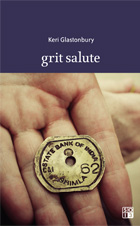Bronwyn Lang reviews “Domestic Archaeology” by Kelly Pilgrim-Byrne
by Kelly Pilgrim-Byrne
Grand Parade Poets, 2012
ISBN
Reviewed by BRONWN LANG
This is Kelly Pilgrim-Byrne’s second publication. Her first, People from Bones, was co-authored with Bron Bateman and the new collection, Domestic Archaeology, “has been ten years in the making and aims to take you on the journey of infertility and out the other side with your optimism left firmly intact.” Pilgrim-Byrne is indeed true to her aspirations and it is the unflinching exposure of the personal that makes this collection so charming. What seems striking about this collection is the anthropocentric inventiveness; the way Pilgrim-Byrne’s use of nature adds layers to her personal poems.
We Mums
A third of Laysan albatross pairs are female and have been known
to couple for up to 19 years.
We’re Laysan Albatross People
co-operatively breeding a new generation
of squawking individuals
(39)
Domestic Archaeology offers the reader a detailed review of Pilgrim-Byrne’s biographical experience and her familial landscape. Fertility / infertility are a central theme and throughout her collection weave a sequence of poems which document the author’s personal journey through four and a half years of IVF treatment with her same sex partner and the eventual birth of their daughter. Pilgrm-Byrne is writing for and from her times. The subject matter of her poetry is unique in its approach to universal themes and their expression in the contemporary world. She uses her poetics to specify and detail the experience of same sex motherhood in lyric and metaphoric layers.
26092007
the slice of her abdomen
the slick and slip, pull and tug
your quivering arrival
delivers the (other) mother
(16)
Domestic Archaeology is a triptych, each territory of which is exceeded in size by the next. These sections chronicle the journey between and beyond fertility / infertility. When viewed as a whole, this narrative appears to begin in medias res with “Venus of Willendorf … Her vulva trapped / between fold and fat, / a luxurious peak / of convergence” (9); this ekphrastic poem also featured in The Best Australian Poetry 2009 anthology.
Like layers of sediment the three subdivisions within Domestic Archaeology, “Excavation”, “Fauna” and “Cataloguing”, invite the reader into a process of unearthing, discovery and construction of narrative.
For those who came before
I feel as if I have let you down
scrubbed out all your hard earned
physical hand-me-downs
broken the chain–a thousand years
of pox on me.
(…)
Yet here’s an intriguing thing about families
–similarities are not all hard-wired
and in our daughter we see facial expressions,
overexcitement, or the flourish of a hand gesture
that have been gifted from you by me to her
a precious package of inheritance.”
(18)
Despite the intimate focus of the narrative, this collection never slips into self-indulgence. In part, this is because the very personal and confessional material dominating the content is tempered with works such as “My Maiden Aunt’s Lips” and “Snake in my laundry room (4am)” which view the author’s immediate surroundings through a wider lens. Perhaps this is the most obvious in Fauna which consists of a series of poems which are deft and analytic in their examination of various living creatures. Any risk of sentimentality is also avoided through Pilgrim-Byrne’s wry sense of humour.
I’m going to build a monument to infertility
where there will be no penises no breasts.
There will definitely be no vaginas–
though there will be lips
and they will be pursed and cinched
and of course, downturned.
These lips will not be dusted red
and they will not be plumped,
they will be …
blue
(14)
Domestic Archaeology deals with powerful emotions and the experiences of grief and loss. These poems appear alongside the ecstatic; harmony is found between the felicitous tone of these works and those of the darker poems such as “Home” written “In memory of Rafferty James Manhatan Downes 15/7/11 – 30/7/11” and “There’s a crack in everything, that’s how the light gets in”.
And I learnt that if there is a God
prayer isn’t the language he understands
because if this Kris guy, after two years of living on the cusp of Hell
has been sent home to make books and videos for his sons …
if there’s no hope for him
then we’d all better learn to let the light in.
(69)
The longest poem in this collection is “Juvenesvcence, variations on a theme”. In this nine part piece aphorism and powerful imagery combine in an impressive whole.
business students learn
how to rule the world, the arts kids shape it
scientists (for better or worse) change it
(42)
… Listen
like drums
with their skin pulled tight
how the young sound
(47)
The poem from which this collection takes its name is an excellent one from which to draw the essence of Pilgrim-Byrne’s solo debut. Here, evocative imagery meets the uncluttered strength of her free-verse.
Like excavators
we sift through simple ruins
carefully
cultivating people from bones.
(50)
Domestic Archaeology is the third collection released by Grand Parade Poets, a press which believes poetry “must be at once elitist and democratic since it brings high-powered imaginative entertainment and intellectual pleasure to those willing to meet it at least part of the way. Grand Parade Poets wishes to publish poets of music, passion and intelligence”[1] and, like Pilgrim Byrnes herself, this publisher also delivers what it promises.
[1] Wearne, A. An Accidental Publisher: Alan Wearne on Grand Parade Poets and Christopher Bantinck, [16.11.2011] spunc.com.au/splog/post/an-accidental-publisher-alan-wearne-on-grand-parade-poets-and-christopher-bantick




